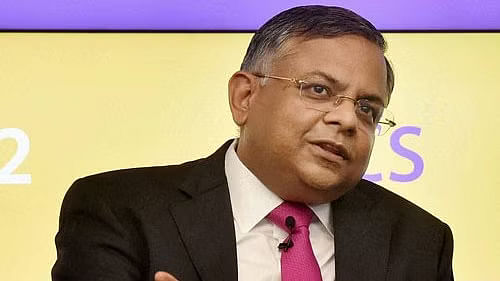
Tata Sons Chairman N Chandrasekaran
Credit: PTI Photo
New Delhi: Late Ratan Tata always ensured employees are taken care of along with the well-being of their families across the Tata Group companies, which shaped a number of leaders across the conglomerate, and there really was no one like him, Tata Sons Chairman N Chandrasekaran said on Monday.
Recollecting his association with Tata (86) who passed away last week, in a post on networking platform LinkedIn, he wrote, "Anybody who met Mr Tata came away with a story about his humanity, warmth, and dreams for India. There really was no one like him." Chandrasekaran, who took over as Chairman of Tata Sons in 2017 after the removal of (late) Cyrus Mistry, said his relationship with late Tata "grew over the years, first focusing on business and eventually evolving into a more personal connection".
"We discussed interests ranging from cars to hotels, but when our conversations turned to other matters -- those of daily life -- he would show how much he noticed and felt. He was someone to be discovered, over time and through experience," he recollected.
Remembering how the late Chairman Emeritus of the group laid emphasis on employee welfare, Chandrasekaran wrote, "Just after I became Chairman, I was introduced to a situation within Tata Motors which involved a dispute between the company and the employees' union over wages for two years." He further noted, in March '17, Mr Tata and I met the union leaders together. During the meeting, Mr Tata relayed three messages: he regretted the delay in finding a resolution. He explained that the company was going through hardship. And both of us committed that this dispute would be concluded within a fortnight.
According to him, "Mr Tata's direction squarely focused on making sure employees were well taken care of -- not just to resolve the dispute, but to ensure their and their families' well-being".
"Across other Group companies, his perspective on employees was uniform. It is something that has shaped a number of our leaders across the Group," wrote Chandrasekaran, who was the CEO of Tata Consultancy Services (TCS) before he became the Chairman of Tata Sons.
Recollecting Tata's love and care for dogs, Chandrasekaran recollected an instance about renovating the group headquarters "Bombay House" around the same time when the dispute at Tata Motors happened.
"... I expressed a desire to renovate our headquarters, Bombay House. Bombay House had not been touched since 1924, and more important (as many people told me) Mr Tata would not like it. "Bombay House is a temple," I was told, emphasising its sanctity," he wrote.
Chandrasekaran recollected when he "finally mentioned to Mr Tata about Bombay House, he (Tata) said, 'May I ask you something? When you say 'renovate', do you mean 'vacate'?' I explained that we planned to move everyone to a nearby office." Tata wanted to know where the dogs, which were an integral part of Bombay House, often seen at the reception, would go.
Chandrasekaran assured that a kennel would be built for them, to which Tata responded saying 'Really?' while considering the proposal.
"When the renovation of Bombay House was complete, Mr Tata wanted to see the kennel first. He was very happy to see how thoughtful the kennel's design was, and how well the dogs would be cared for," he noted.
Chandrasekaran further recollected, "Seeing his happiness with the kennel and his priorities was a reminder that while big projects are important, it's the details that reveal how we think, what we prioritise, and how we are perceived. His joy was confirmation that we had done the right thing." According to him, if Tata ever visited a place, he could recall everything -- from the placement of (the) smallest piece of furniture, the lighting, colours, and so on.
"His memory was photographic. He remembered the covers and content of books and magazines and referred to them even years later. He was always observing and processing, from large ideas to minute detail," Chandrasekaran said.
Stating that there is so much else to say about who Tata was, he said, "but for now, as I process his absence, this will have to do: His eye received everything clearly, as his mind perceived everything clearly."